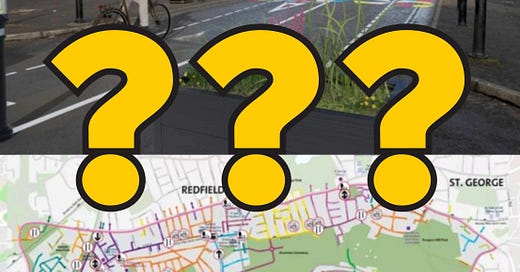I've written and posted up a fair few pieces about the controversial proposals for a liveable neighbourhood scheme in the east of Bristol, running from Barton Hill, through Redfield and on to to St. George. This is the most recent one I wrote: How hard is for 'Liveable Neighbourhood' advocates to grasp a very simple concept? 19.7.23. The controversy over the scheme is not going away. One reason it's not going away is because of the way the next phase of 'consultation' will be undertaken, as reported in this piece: Bristol campaigners want fair say on 'liveable neighbourhood that nobody wants' - Alex Seabrook | Bristol Post | 23.10.23.
It's a widely held view that the initial consultation was not adequate. Despite pressure from a number of residents and the campaign group, Keep Bristol Moving, for a wider consultation, Bristol City Council instead will be asking people for their views on the individual Traffic Regulation Orders (TROs) that will be used to build the scheme. They will not be asking residents for their views on the scheme in its entirety.
Asking for comments on individual TROs is nothing more than a cynical, salami slicing tactic preventing discussion about the scheme as a whole. It reminds me of the shite we had to put up with from Highways England (now National Highways) about the proposed Lower Thames Crossing when we were living back in Thurrock. At the 'consultations' they organised, residents could question them on the detail of the route such as junctions, embankments, cuttings, bridges and the like. Any discussion about the need for the crossing was swiftly dismissed.
If Bristol City Council are intent on breaking up any discussion of the scheme down to comments about individual TROs, then people can be forgiven for thinking that they intend to push this scheme through regardless, rather than listen to people's genuine concerns about its impact as a whole. It's not just about the lack of joined up thinking needed about travel in and around Bristol to set the context for the establishment of any liveable neighbourhood scheme, it's also a deeply cynical move with a whiff of divide and rule about it.
It has also been pointed out that one of the reasons the initial consultation was considered to be inadequate was the fact that it wasn't that tailored to embrace the entire spectrum of the demographic in the area the scheme is intended to cover. This was explained by Chris Johnson of Keep Bristol Moving:
“The initial consultation was inadequate, which is the feeling among local people. There’s an awful lot of elderly people who won’t engage with an online consultation, and a lot of people who speak English as a second or third language. ‘Modal filters’? Just say bollards, nobody knows what a modal filter is. We went around leafleting in the area, and when you spoke to people about it, loads of them hadn’t heard of it.”
Yet again, I feel obliged to state the bleeding obvious. Any scheme that's intended to reduce traffic flows through a neighbourhood will only end up displacing that traffic elsewhere unless there's a comprehensive plan to reduce traffic volumes not just in the city but also the surrounding region. The only proven way of doing that is by having a reliable, attractive public transport system in place. You don't need me to tell you that public transport in Bristol and the surrounding region, both bus and rail, is not fit for purpose. You also don't need me to tell you that with the squabbling that's going on between the West of England Combined Authority, Bristol City Council and the other councils in the region, we're a long way from ever getting a public transport network that's fit for purpose.
Looking at things in greater depth, it has to be recognised that decades of planning policy based on the assumption of near universal car ownership has resulted in our cities and towns sprawling in such a way that driving is a necessity for a lot of people. At some point, there has to be a serious discussion about how we can start to rethink the way we live and work in order to reduce that dependency. This is dealt with in some depth in the latter part of this piece: The future of movement on a finite planet 20.2.23. Suffice to say, there are no easy answers...






The creation of a neighbourhood ZONE is the whole problem with this scheme. It underlies the reason why local and public views are not considered. The money comes from weca and further afield with strings attached. Public say over public money!